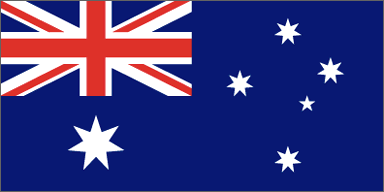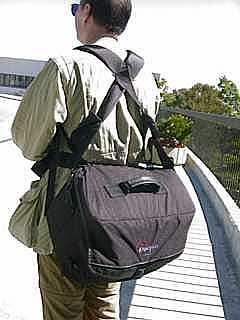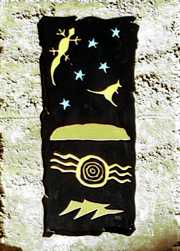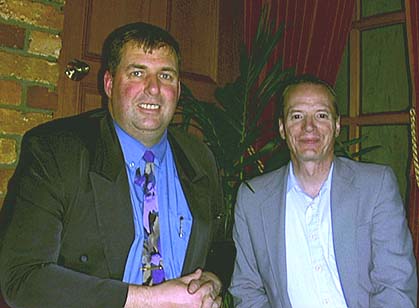Last updated: 7 October 1999
Last updated: 7 October 1999 |

 Laurraine (my wife) and I visited Australia for three weeks in August and September 1999. The original purpose of the trip was to attend the 57th World Science Fiction Convention, which was being held in Melbourne the first week of September. But since traveling from the United States to Australia is a major undertaking we decided to make a long visit to Australia to see its sights. And since several of our planned stops in Australia offered the opportunities for wonderful views of the Southern Skies I decided to take my ETX-90RA along on the trip. I chose to carry the ETX using the softsided case available from Shutan Camera & Video since it included the option of being carried as a backpack, which was much more convenient than a normal, over-the-shoulder case. The case, as seen in the photo on the right, was loaded (probably overloaded) with the ETX, a 35mm camera, 3 camera lenses including a 90-230mm zoom telephoto, eyepieces, filters, JMI Piggy-back Camera Mount, Meade Basic Camera Adapter, Meade T-Adapter, cables, and star charts printed with Voyager II 2.0 software. The case performed great even though stuffed. As a backpack it was very comfortable while walking long distances from the terminal to the gate, yet easy to remove for the Security check. It fit nicely through the restricted entry on the X-ray machine. And it was easily placed in the 747 overhead storage bin. I placed the JMI Tripod and Wedge in my checked large suitcase. The wedge was required since I would be at some latitudes unsupported by the tabletop ETX legs.
Laurraine (my wife) and I visited Australia for three weeks in August and September 1999. The original purpose of the trip was to attend the 57th World Science Fiction Convention, which was being held in Melbourne the first week of September. But since traveling from the United States to Australia is a major undertaking we decided to make a long visit to Australia to see its sights. And since several of our planned stops in Australia offered the opportunities for wonderful views of the Southern Skies I decided to take my ETX-90RA along on the trip. I chose to carry the ETX using the softsided case available from Shutan Camera & Video since it included the option of being carried as a backpack, which was much more convenient than a normal, over-the-shoulder case. The case, as seen in the photo on the right, was loaded (probably overloaded) with the ETX, a 35mm camera, 3 camera lenses including a 90-230mm zoom telephoto, eyepieces, filters, JMI Piggy-back Camera Mount, Meade Basic Camera Adapter, Meade T-Adapter, cables, and star charts printed with Voyager II 2.0 software. The case performed great even though stuffed. As a backpack it was very comfortable while walking long distances from the terminal to the gate, yet easy to remove for the Security check. It fit nicely through the restricted entry on the X-ray machine. And it was easily placed in the 747 overhead storage bin. I placed the JMI Tripod and Wedge in my checked large suitcase. The wedge was required since I would be at some latitudes unsupported by the tabletop ETX legs.
We departed from Los Angeles International Airport on 15 August and arrived in Melbourne on 17 August, losing a day to the International Date Line. We transferred to an Australian airline (a long walk but made easier by the backpack) and again the case fit easily into their 767 overhead storage bin. This flight took us to Sydney where we stayed for two days and nights. Sydney's latitude is 33 degrees, 54 minutes South; or about the same as my location in Southern California, but on the other side of the equator. Unfortunately, time did not permit getting away from the city lights in Sydney so the ETX was never unpacked. But I did get the chance to see the First Quarter Moon, which looked strange appearing in the northern sky with the illuminated portion on the left (opposite to what I was used to from the Northern Hemisphere). On 20 August we flew to Cairns, latitude 16 degrees, 55 minutes South, the most northern of our stops in Australia. This tropical location frustrated my astronomical observations with night and early morning clouds and rainshowers, however, I did manage to finally get my first look at Alpha and Beta Centauri, and the Southern Cross from here. Unfortunately, the Moon was just past First Quarter and so prevented me from seeing the Coal Sack. It was interesting to see Sagittarius nearly straight up instead of low in the southern sky. We spent three days and nights in Cairns but the ETX was never unpacked due to the weather. On 23 August we flew to Alice Springs, latitude 23 degrees, 42 minutes South, where we stayed one night. The weather was good but the bright Moon prevented any useful observing/photography, so the ETX stayed packed.
On 24 August we took a tour coach from Alice Springs to Ayers Rock, latitude 25 degrees, 21 minutes South. In this desert climate the sky was clear and I held out strong hopes of being able to finally use the ETX during the two nights we were to be at Ayers Rock Resort. I even unpacked it and the tripod/wedge, set it up, mounted the camera, and waited for nightfall. At 1930 hours, although the Moon was nearly Full, Alpha and Beta Centauri were brilliant and the Southern Cross easily seen. There was a faint milky area visible that was the Milky Way. Antares was straight up. Unfortunately, the sky was too bright and the Moon too near the Southern Cross for piggyback astrophotography so I elected to wait until the next night when at least the Moon would be a little further away from the Southern Cross. At 0330 hours on 25 August I went outside to view the Magellanic Clouds. But I was frustrated in my attempts due to the nearly Full Moon making the sky very bright. Using binoculars I did see a small patch of nebulosity near the location of both the Small Magellanic Cloud and the Large Magellanic Cloud. I also noted Canopus and several other prominent southern stars. But no astrophotography was attempted this morning due to the sky brightness. One other observation of note: at sunset the previous night and at sunrise this morning the Earth's shadow was very visible. This was due to the very flat terrain  at Ayers Rock with a clear horizon all around (except for Ayers Rock itself and The Olgas). During the afternoon of 25 August some clouds began to appear on the horizon (oh no!) and at nightfall they approached the Southern Cross. I watched in horror as my last, best hope for some shots of Alpha and Beta Centauri and the Southern Cross disappeared. The night remained cloudy so I packed the ETX and tripod/wedge. The next morning was bright and clear. Rats.
Before leaving Ayers Rock Resort on the morning of 26 August I took the photo on the right of the Ayers Rock Resort emblem so that I could say that I got a photo of the Southern Cross.
at Ayers Rock with a clear horizon all around (except for Ayers Rock itself and The Olgas). During the afternoon of 25 August some clouds began to appear on the horizon (oh no!) and at nightfall they approached the Southern Cross. I watched in horror as my last, best hope for some shots of Alpha and Beta Centauri and the Southern Cross disappeared. The night remained cloudy so I packed the ETX and tripod/wedge. The next morning was bright and clear. Rats.
Before leaving Ayers Rock Resort on the morning of 26 August I took the photo on the right of the Ayers Rock Resort emblem so that I could say that I got a photo of the Southern Cross.
Next it was on to Melbourne, latitude 37 degrees, 49 minutes South, our final and most southern stop in Australia. The Shutan case really worked well today. We had a plane change in Sydney and had to walk from one terminal to another. I hardly noticed the load on my back and the case fit perfectly into the 737 overhead storage bin. When we arrived in Melbourne it was pouring down rain. I hoped it was not a bad omen.
On 29 August the skies finally cleared somewhat and at 2030 hours I was able to see Alpha and Beta Centauri and the Southern Cross from outside our hotel in downtown Melbourne. I found a reasonably dark location, somewhat shielded from the city lights, just outside the hotel along the Yarra River. I decided that this would be the location where I would try to photograph Alpha and Beta Centauri and the Southern Cross. But this night was not ideal as some high wispy clouds and constant seagulls flying overhead would have ruined any attempts. I did unpack the tripod and wedge but left the ETX in its case as I would need that to get the ETX from the hotel room to the location beside the river. The clouds returned the next day, although some days were clear only to cloud up again at dusk. On 2 September it was sunny and clear and my hopes rose. With the Moon gone from the evening sky I figured I would have a chance if it just stayed clear. And stay clear it did! So out I went to the river's edge with my ETX (in its case) and the tripod/wedge. I unpacked the ETX and set it up, mounted the 35mm camera piggyback, and as I positioned the tripod I noticed something very strange. The magnetic compass I had mounted on the wedge to assist in locating the earth's axis was not pointing in the expected direction, even allowing for magnetic variation. I pulled out a spare compass, which pointed in a different direction entirely! Somehow the wedge had become magnetized during the trip! I was glad I had the spare. I aligned the ETX using the spare compass, which would get me close enough to being polar aligned since I could not see the southern pole region well enough due to the city sky brightness, and began taking photos, starting with a 30 second exposure. I figured I would take each photo longer than the previous one; that way I would have a better probability of getting a decent photo before the sky brightness overcame the stars. My second shot was 1 minute but my third shot, intended to be 2 minutes, was interrupted by a low flying airplane. I retook the 2 minute exposure and then a 5 minute exposure. But the wind came up during the 5 minute exposure making guiding with the Rigel Systems PulsGuide and Scopetronix Microstar II+ very challenging. My guide star was doing loop-de-loops and figure eights in the eyepiece! I wonder what the image will look like on 35mm film. I then started a 10 minute exposure but surprise, here came the clouds. RATS! This turned out to be the last clear night for the remainder of our stay in Australia. But I'm hopeful that at least one of photos will turn out OK. With the 55mm lens on the camera I was able to get Alpha and Beta Centauri and the Southern Cross in the same frame. Aircraft, seagulls, and wind made the night's attempts interesting... I have posted the only worthwhile photo on the Astrophotography Gallery - Sky page.
During our stay in Melbourne we got the chance to meet a fellow-ETXer and super nice guy, Scott Patten. He was kind enough to take us to the Victoria Market in Melbourne and the St Kildas Beach craft market for some shopping. Later in our stay in Melbourne we had dinner with Scott (he's the guy on the left). Thanks Scott!

On the night of 5 September I repacked the ETX since it was cloudy and on 6 September at 1130 hours we left Melbourne for Los Angeles, gaining the day we lost at the beginning of our trip, arriving in Los Angeles at 1120 hours on the 6th. Both Laurraine and I enjoyed our vacation in Australia and definitely look forward to going back someday. I will definitely check the Moon Chart before we make the travel arrangements so that I will have dark skies!
Go back to the Observatory Visits page.